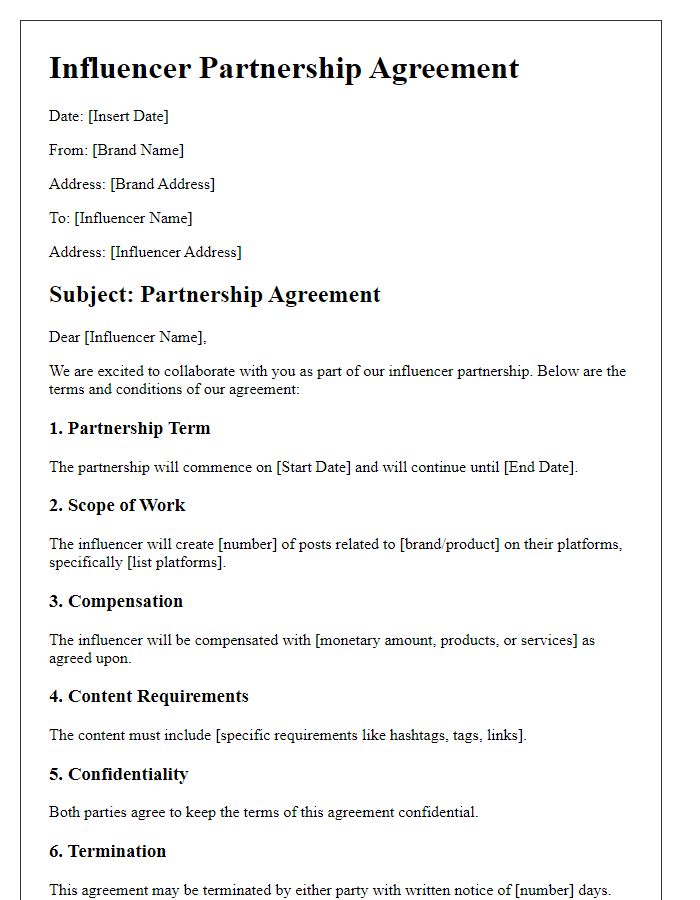Are you ready to take your brand to the next level with influencer marketing? Creating a solid agreement is essential for ensuring that both parties are on the same page and that the campaign runs smoothly. In this article, we'll guide you through the key components of a letter template for an influencer marketing campaign agreement that protects your interests while fostering a productive collaboration. Let's dive in and explore how you can make the most of your influencer partnerships!

Parties Involved
An influencer marketing campaign agreement involves multiple key parties collaborating to create engaging promotional content. These parties typically include the Brand, which is the company or organization seeking to promote its products or services, and the Influencer, who is an individual with a substantial online presence, often on platforms like Instagram, YouTube, or TikTok. Additionally, the Marketing Agency may be involved, acting as an intermediary to strategize and execute the campaign. Each party plays a critical role: the Brand provides the products or services, the Influencer creates authentic content showcasing these products to their audience, and the Marketing Agency ensures that the campaign aligns with the brand's objectives, manages logistics, and analyzes performance metrics. This collaborative effort aims to enhance brand visibility and drive engagement in today's digital marketing landscape.
Campaign Objectives
Influencer marketing campaigns aim to enhance brand visibility and engagement through strategic partnerships with social media influencers. Specific objectives include increasing brand awareness by at least 30% over three months, measured through social media metrics such as impressions (number of times content is displayed) and reach (unique users exposed). Additionally, generating a minimum of 500 direct clicks to the brand's website from campaign-specific content can drive traffic and subsequently lead to a 15% increase in conversion rates. Furthermore, leveraging influencers' authentic voices should foster community trust and encourage user-generated content, aiming for at least 100 mentions of the brand across platforms like Instagram and TikTok. These goals align with the overall marketing strategy to solidify market positioning within the competitive wellness industry.
Deliverables and Content Guidelines
Influencer marketing campaigns require clear deliverables and content guidelines to ensure alignment between brands and influencers. A typical agreement may outline specific content types such as Instagram posts, stories, and YouTube videos, emphasizing the need for high-quality visuals. Key performance indicators like engagement rates (likes, comments, shares) may also be included to measure success. The timeline for content delivery should be defined, often spanning 8 to 12 weeks, to maintain timely promotion. Specific brand messaging must be adhered to, emphasizing product benefits and calls to action. Additionally, the agreement might stipulate disclosure requirements as per Federal Trade Commission (FTC) guidelines, ensuring transparency about sponsorship. Lastly, usage rights for the content produced may be addressed, allowing brands to leverage influencer-generated media across multiple platforms.
Compensation and Payment Terms
Influencer marketing campaigns often involve clear compensation and payment terms to establish mutual understanding. Common compensation methods include monetary payment, typically defined as a fixed fee or per-post rate, alongside options for product exchanges, where influencers receive goods in return for promotional content. Payment schedules can vary, with upfront payments or performance-based milestones being popular structures. Terms may specify payment methods, whether via bank transfer or digital platforms like PayPal, and detail the timeline for payment processing, commonly ranging from 30 to 90 days post-invoice submission. Transparency in these agreements helps ensure a smooth collaboration between brands and influencers, fostering long-term relationships.
Duration and Termination Conditions
Influencer marketing campaigns establish clear agreements on duration and termination conditions to ensure both parties understand their commitments. Typically, these agreements define a specific campaign period, for instance, six months starting from the launch date of the campaign, with explicit start and end dates. It is crucial to include conditions under which either party may terminate the agreement, such as failure to meet deliverables, violation of brand guidelines, or lack of compliance with applicable laws governing advertising and promotions. Additionally, clauses regarding notice periods, such as a minimum of 14 days written notice before termination, provide clarity. In the event of termination, stipulations outlining the settlement of dues for completed services and how intellectual property rights related to content will be handled post-termination are typically included. Understanding these elements fosters a transparent and professional relationship between brands and influencers.













Comments